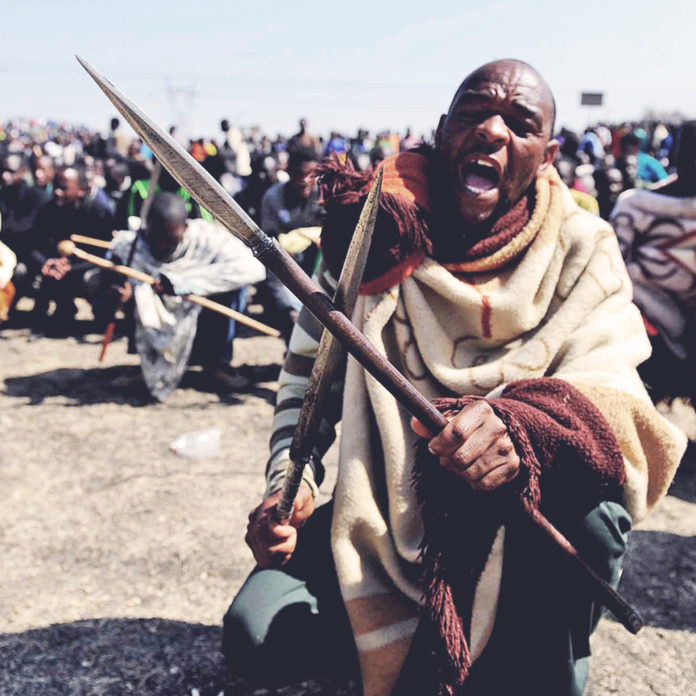
Marikana platinum mine, near Rustenburg, August 16, 2012: 34 miners killed by police, at least 78 people injured.
June 27, 2016: A small carload containing a couple of activists and two of their children arrives at a house in Marikana for a last minute planned sleepover and a trip to the koppie where the massacre took place.
SETTING THE SCENE
I had flown up to Joburg a few days earlier to compete in the Icon Game and Comic convention’s Settlers of Catan competition. It had not gone well; I had been sick since the day after I arrived and it was starting to feel like this whole trip was a waste.
Monday rolls around and I’m staying with my friend Nigel Branken, who lives in Hillbrow and is involved in a number of exciting community development conversation and actions. We end up having coffee with a friend of his, Napoleon Webster, who has a house at Marikana, and before I know what’s going on, we’ve decided that a road trip and sleepover will be a great idea.
Suddenly this trip feels like it has done a 180 degree turn. Only a week ago had I finally managed to get my eyes on a copy of the Marikana documentary by Rehad Desai, Miners Shot Down, which I’d been wanting to see for months. I believe it is a must-see for anyone living in South Africa, trying to navigate issues or race and justice.
And suddenly, we, along with two sons of Napoleon and Nigel, are in a car, armed with blankets and braai food, heading for Marikana.
THE VISIT
On the way, we stopped off briefly at the Hector Pieterson monument, which is in the exact place where 13-year-old Hector was shot and killed during the Soweto uprising of 16 June, 1976.
Today, 16 June is Youth Day, reminding us how key the youth were in standing against the brutality of the apartheid government.
It was a brief but powerful moment to look back and reflect on a significant moment in our country’s history.
Then we arrived at Marikana and had a meal together and heard some stories as well as meeting a number of the residents of the area, many of whom are employed at the mines. We got to hear some of their story and circumstances and it was deeply moving.
The following morning we drove up before sunrise (with people already heading for work and the mine up and going already) and spent some time in silence at the koppie. The mixture of peace and presence combined with the memory of the footage I had seen just a week earlier, of violence and confusion and ruthlessness and collusion.
CAN’T WE JUST FORGET AND MOVE ON?
I find that many people who are not wanting to engage with issues of justice and race often bring that one up. The past is the past – can’t we all just move on?
George Santayana was the man who said: “Those who cannot remember the past are condemned to repeat it.”
But the Marikana massacre was the single most lethal use of force by South African security forces against civilians since 1960. And it happened just four years ago. This is fresh. The scars have barely started to heal. Some never will. But in order to move forwards I am convinced that we need to keep the past close to us, as a reminder. As a motivator. As a warning of what we have been capable of and likely will be again.
WHAT CAN I DO?
I believe I was so privileged to get that opportunity and am so grateful to Nigel and Napoleon for making it happen. We probably can’t all hook up a sleepover at Marikana. But we can find a way to watch Miners Shot Down and start to educate ourselves on what is going on in our country.
We can get hold of books like How Can Man Die Better by Robert Sobukwe, Run, Racist, Run by Eusebius McKaiser or Begging to be Black by Antjie Krog. If you’re in Cape Town there is the Slave Lodge, the District Six museum or the Holocaust museum, whereas Joburg has The Apartheid Museum – all difficult places to walk through that help tell us important stories of our past.
There are independent movie makers who run regular movie nights all over the place, giving us a chance to hear the same stories through different voices as well as brand new stories educating us about where we are and where we’ve come from.
So many ways for us to really start growing our engagement with the story of our country past and present. And this I feel is vital if we want to be a significant part of helping tell a new interconnected story, which I think we all need to be doing.
Why not share a story in the comments section of something you read, or saw, or experienced, that helped you gain some momentum in this journey?
